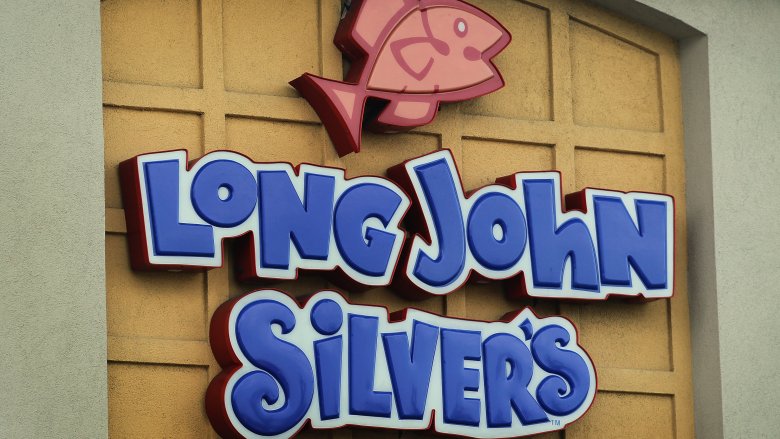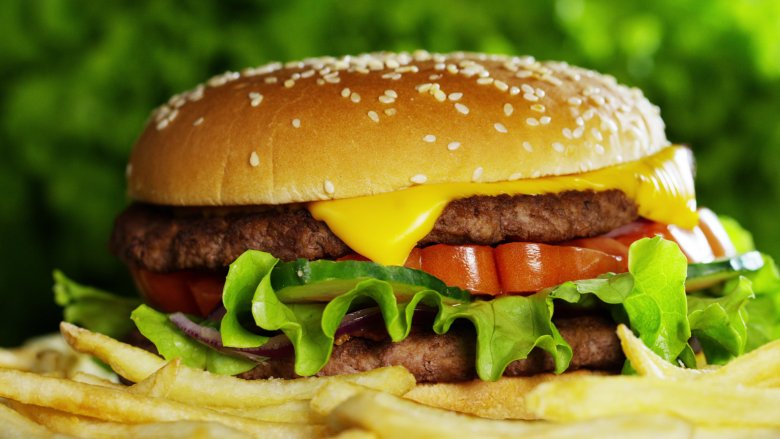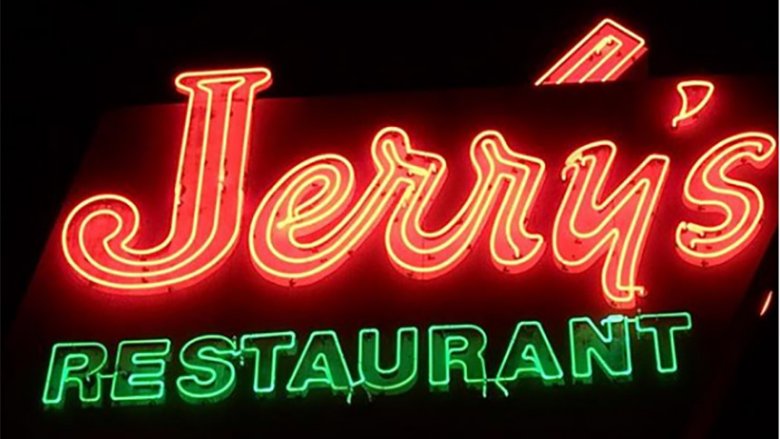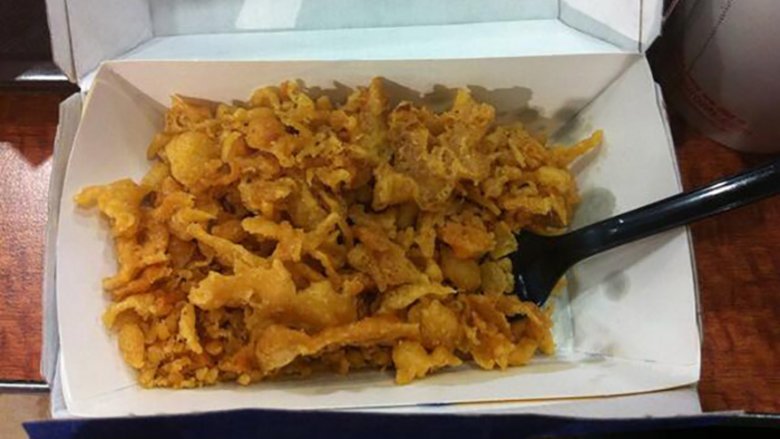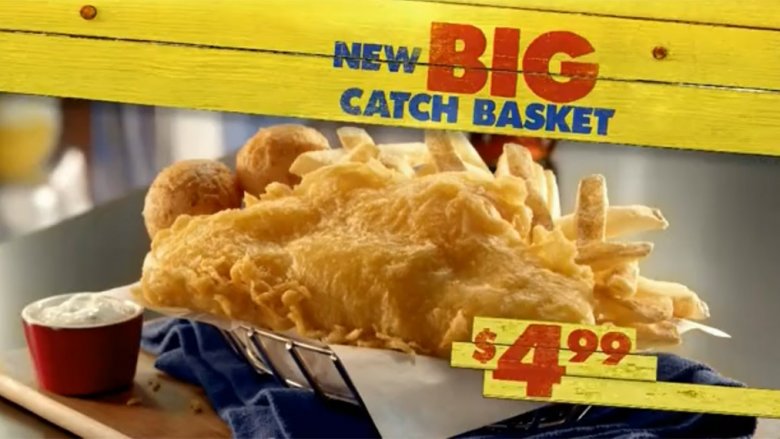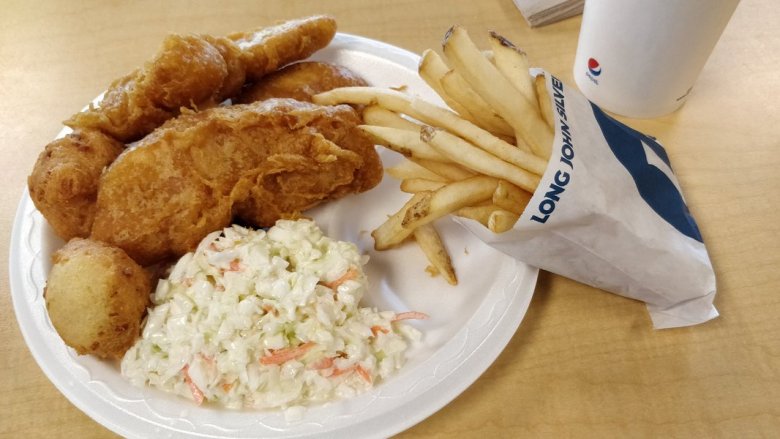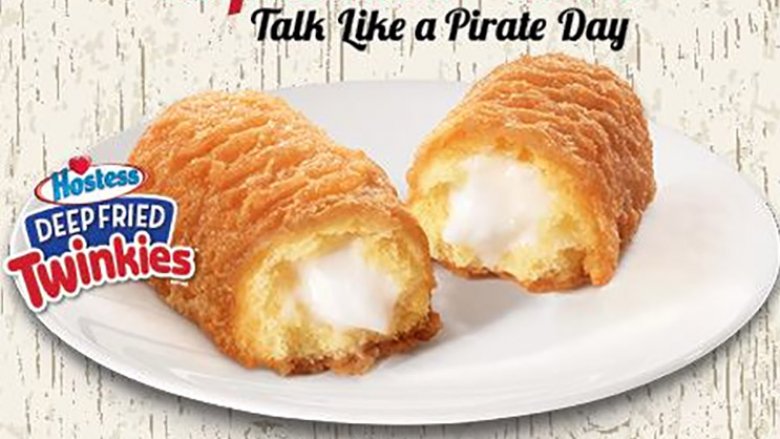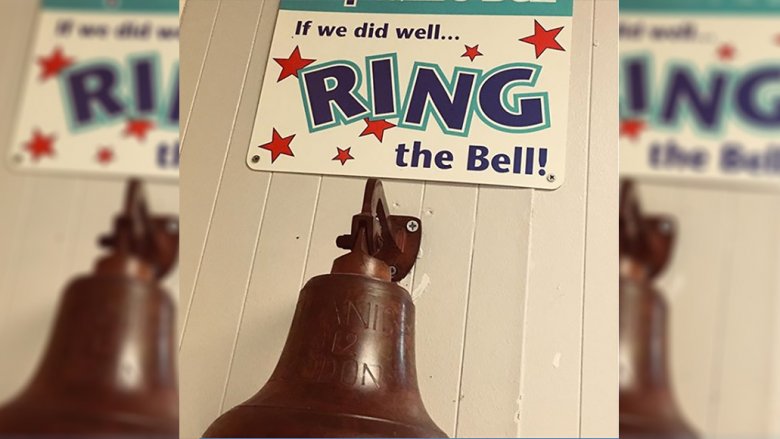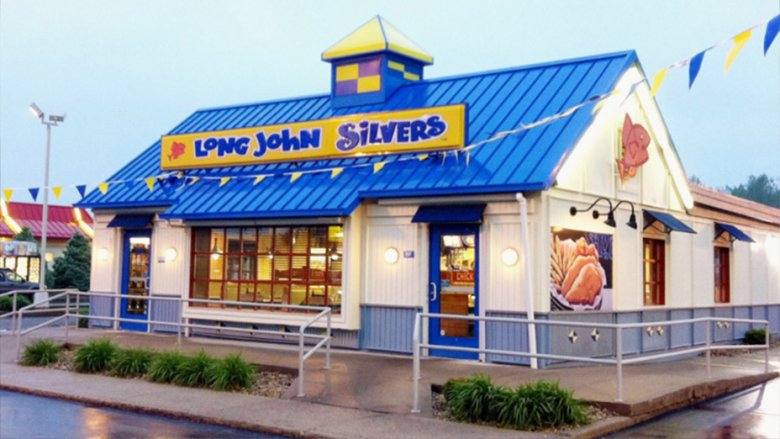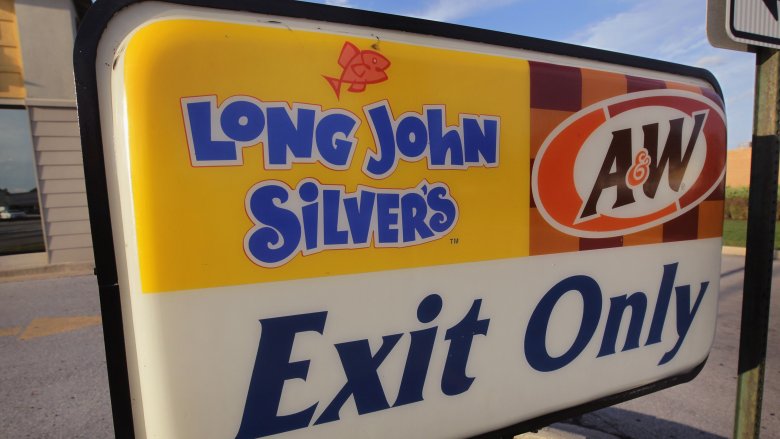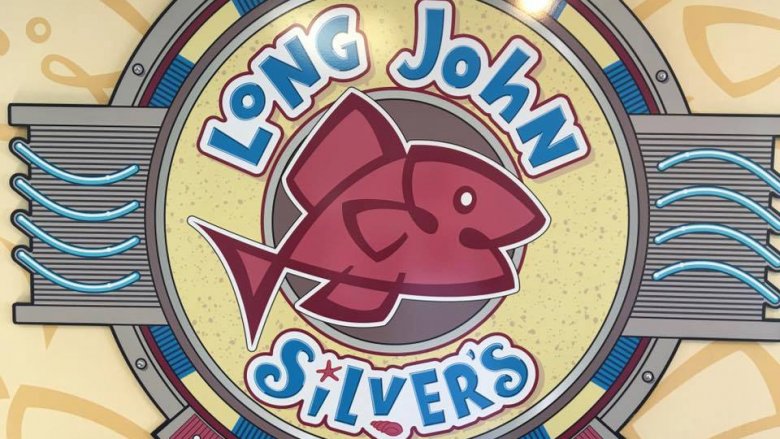The Untold Truth Of Long John Silver's
There are numerous fast food burger chains out there, but in terms of seafood, it's a bit of a smaller pond. The big fish of course is none other than Long John Silver's. The restaurant that takes its name from the Treasure Island character is the largest slinger of deep-fried fast food fish in the United States, and has been for just over 50 years.
The company bills itself as a quick service answer for fried fish and chips, but has been weighed down in recent years with financial troubles and criticisms for its unhealthy food. To Long John Silver's credit though, they made the move to a "100 percent soybean oil that is trans-fat free" back in 2014. Even so, the seafood chain still hasn't managed to find smooth sailing waters, despite its efforts to rebrand itself. Let's dive into the history of this American fast food institution and examine where it's been and where the Long John Silver's ship could be sailing to next.
It started with hamburgers, not seafood
Long John Silver's is of course, all about seafood, however, like many fast food joints, it's story started with a simple hamburger stand way back in 1929.
Jerome Lederer opened a small six-seat hamburger stand called the White Tavern Shoppe in Shelbyville, Kentucky at the start of the Great Depression. Whereas most people wouldn't even think about starting up a business during the rough economic period, Lederer's business model thrived and he eventually opened a total of 13 White Tavern Shoppes. Then World War II came along and Lederer was forced to close 10 of them due to shortages in supplies and manpower.
Not to be discouraged, Lederer established the restaurant group Jerrico Inc. in 1946 and opened a restaurant in Lexington, Kentucky called Jerry's Five and Dime. Jerry's had numerous locations and Lederer hired a man named Warren W. Rosenthal to help run the company and eventually take ownership in 1963 after Lederer passed away. Eager to try a restaurant idea outside of hamburgers, Jerrico tried a number of different menu themes, from roast beef to Spanish food. Finally, Rosenthal teamed up with James Patterson, a franchisee operator of one of the Jerry's restaurants. The two men decided that the market was lacking a fish and chips restaurant and boom — the first Long John Silver's Fish & Chips was opened up in 1969.
The restaurant seems reluctant to acknowledge its history prior to 1969
You might assume that Long John Silvers would embrace their fast food family tree roots that date back to hamburgers and the Great Depression, but that doesn't seem to be the case. The company's history on Long John Silver's official website doesn't stretch back prior to 1969, when they officially opened, without talk of the family of restaurants that brought them into being. There's no mention at all of Jerome Lederer, Jerrico Inc., Warren W. Rosenthal, or any of the Jerry's restaurants that are still operating in Kentucky today.
In fact, LJS almost makes it seem as if Jim Patterson just woke up one day and launched Long John Silver's all on his own. "An enterprising businessman and restaurateur named Jim Patterson returns from a vacation on the coast where he'd experienced a truly exceptional Fish and Chips meal," reads the LJS website. "His vision was simple: Bring this unique seafood experience from the coast to the rest of America so they can enjoy it, too."
Perhaps it's because Long John Silver's was bought by Yum! Brands in 2002 and then sold to a consortium of franchisee leaders and investors under the title LJS Partners LLC in 2011 — which included Jim Patterson himself. Whatever the case may be, Long John Silver's management's lack to acknowledge 40 years of family history seems just a little bit fishy.
Crispies are an off-the-menu side item
Whether you call them crispies, cracklins, crunchies, or just crumbs, any order of fried fish at Long John Silver's is going to come with them. They're those extra droppings of the fried batter Long John Silver's uses in all of their fried food dishes. If you normally disregard those crispies and toss them out when you finish your main meal, then you've been throwing away a secret menu item all these years. Crispies might just look like crumbs, but any LJS regular knows that they're an extra treat to be enjoyed.
As Paste writer and Long John Silver's fan Jim Vorel has noted, the restaurant staff is trained to treat these fried crumbs of batter as an unofficial side item. Vorel notes that he learned this after watching a small child walk up to the counter and ask for some crispies. "There I was, watching in rapt fascination and wondering what exactly he was requesting, when a worker emerged from the back carrying a fry container," wrote Vorel. "A fry container completely filled with crispies, which the fat little child gleefully took back to his booth and began to lustily devour."
Enjoy those crispies, folks.
They made the unhealthiest meal in America
Considering that almost every main entree item is deep-fried to a golden brown and the restaurant gives away bags of fried crispies, nobody's turning to Long John Silver's for health food. Even with a reputation for not having the healthiest grub, it takes some effort to win the accolades of "Worst Restaurant Meal In America." In 2013, the Center for Science in the Public Interest gave Long John's "Big Catch" meal the not-so-praiseworthy title. So what does the worst restaurant meal in America look like exactly?
Well, it was a 4.5 ounce fish fillet, onion rings or fries, and hushpuppies — all deep-fried, of course. While the meal didn't take the highest calorie count in the fast food division — topping out at 1,320 calories — its sodium and trans fat levels were out of control. The American Heart Association recommends that people only eat around two grams of trans fat a day, and the Big Catch had 33 grams of trans fat and 3,700 milligrams of sodium. Maybe it was merely coincidence, but when The Onion writes an article about your food with a fictional menu item called "abomination from the deep," maybe it's time to consider stepping back from the deep fryer.
Lent is big business for the restaurant
Long John Silvers doesn't mess around when it comes to lent — that's when it's time to move some serious fish. The religious observance beginning with Ash Wednesday and concluding with Easter is observed by an estimated 1.2 billion Catholics who abstain from eating meat on Ash Wednesday and all of the Fridays during the 40-day Lenten period. The executives at Long John Silver's have dollar signs in their eyes during this time of year, and cater to the many Catholics choosing to eat more fish in place of meat.
"We are expecting a good Lent," James O'Reilly, CEO of Long John Silver's, said about the 2018 Lenten season. "Last year, we sold more than two million pounds of seafood, and the fact that Lent is starting sooner is good for us." To give you some perspective on just how much business booms for the seafood franchise, they saw a 130 percent increase on Ash Wednesday in 2017 and average sales increase of 84 percent on every Friday during the season.
In order to reel in as many customers during Lent as possible, LJS offers special coupon books to Catholic churches, hands out "Fry Day" customer loyalty cards, and runs contests to win Alaskan and Caribbean cruises.
Talking like a pirate will get you free food
Crispies aren't the only free food on the menu. Long John Silver's has embraced perhaps the silliest of internet holidays — talk like a pirate day. It only makes sense for the restaurant to cater to every landlubber around in need of a fried food fix, and anybody who does their best pirate impression on the holiday is rewarded with something delicious. In 2018, it was a free Twinkie — deep fried, of course.
"Talk Like a Pirate Day is for all me hearties who love a good deal and don't want to be hornswoggled," Stephanie Mattingly, Vice President of Marketing said. "We love to see our customers' excitement and are thrilled to share the bounty."
If you really wanted to go all out for the pirate holiday, you could have even earned a free Fish N' Fry if you were willing to dress like a pirate. Blackbeard and Captain Kidd impressions aside, LJS used the gimmicky holiday for a good caused and in 2017 raised $50,000 for the the American Cancer Society.
They want you to make some noise
Maybe the Long John Silver's crew gave you some extra crispies with your meal or your fish and shrimp platter was fried to perfection. Whatever the case, customers who enjoy their meal are encouraged to ring the Captain's Bell on their way out of the restaurant to let staff know that they had a satisfactory visit. The LJS tradition comes from a maritime practice where all ships had bell that was used for everything from letting the crew know what time it was to its use as a safety precaution in foggy conditions. If a ship was captured, the ship's bell even became a trophy of sorts. Of course, at Long John Silver's, it's all about dining landlubbers expressing their joy of hushpuppies.
Ringing the Captain's Bell is about the least modern way of garnering customer feedback possible, but oddly enough this led to the inspiration for a customer feedback startup known as Humm. Humm founder Bernard Briggs was eating at a Long John Silver's when he noticed customers ringing the Captain's Bell after their meals. That was all it took for Briggs to develop his tech platform for restaurants to collect and analyze customer feedback into usable data. Briggs even keeps a souvenir reminder of the idea that started his company. "One of my co-founders gave me for Christmas last year a Long John Silver's Captain's Bell he found on Ebay," Briggs said.
The chain nearly sank in the 1990s
Long John Silver's has seen some rough waters over the years, and ship nearly went down in the late 1990s. In 1998, the company filed for Chapter 11 bankruptcy after weathering a decade of financial hardships and taking on more debt than it could handle. "Right now, it seems they need to get their creditors off their backs," Edward Jones analyst Patrick Schumann told the Chicago Tribune at the time.
Long John Silver's dealt with its fair share of hardships in the 1990s, including a lawsuit from a West Virginia-based company who accused them of ripping off the slogan "grab and go." That was followed up with yet another lawsuit that claimed Long John Silver's was within breach of contract and fraud after it failed to pay a fee of $3 million for promotional toys for the 1998 movie Lost in Space. If A&W hadn't swooped in and acquired Long John Silver's in 1999, it's very possible that the restaurant could have soon been sleeping with the fishes.
Long John Silver's combo restaurants have mostly been a disappointment
The restaurant chain has also had plenty of internal strife to deal with over the years. You might recall seeing co-branded A&W and Long John Silver's locations — that was happening even before Yum! Brands bought the restaurant chains. After they were purchased by Yum! in 2002, they were also paired with KFC or Taco Bell, though not as commonly. When the concept began it was sort of a success. "The restaurant is recording sales comparable to a free-standing restaurant," Bryon Stephens, vice president of franchising said of one such restaurant combo in 2001.
Unfortunately, those Frankenstein restaurants eventually saw their financial success start to wither away.
In 2010, Treasure Isle Inc. who owned and operated Long John's and A&W franchise locations sued its parent company, Yum! Brands, arguing that Yum! failed to properly support the restaurants and as a result, locations were either closing or being weighed down by the anchor of debt. "The co-branding was a failure," said Wayne Mack, an attorney representing Treasure Isle Inc, who argued that standalone restaurants received more support for corporate. It's possible that one reason the combo restaurants had problems was simply a lack of communication. Mack argued that A&W had veto power over operational standards and that Yum! kept franchisees in the dark about cross promotions and combo specials.
One year later, Yum! had washed Long John Silver's fish grease from its hands and said good riddance.
Long John Silver's is trying to get back on course
After weathering bankruptcy in the late '90s and a bad experience with Yum!, Long John Silver's has seen its fair share of stormy seas. The seafood restaurant hasn't given up hope though, and has made efforts to rebrand itself and get back on course. The company appointed new CEO James O'Reilly in 2015 and is promising to add more grilled items to the menu to appease the growing number of health-conscious customers. You may have also noticed that they rolled out new uniforms and changed the signs, ditching the old-style font and flag of the 1980s and '90s in favor an updated blue lettering with a fun red fish. New uniforms and logos can only take you so far though, and it might not be enough.
The restaurant chain was operating 940 locations as of 2017, but it's still rough sailing for this battered ship. The company closed 16 restaurants in 2014, a few more in 2015 and 2017, and reviews of its existing locations have been less than stellar. In 2017, Business Insider visited a location in Staunton, Virginia to get a firsthand look at the company's turnaround. It's kind of difficult to get excited about checking out a restaurant when the review includes phrases like "grubby and claustrophobic" and "borderline palatable."
Only time will tell, but Long John Silver's could one day be walking the plank.
